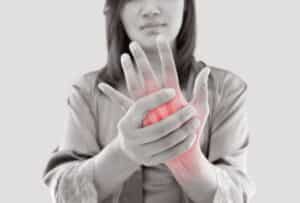Self Care for Early Arthritis

According to the CDC, “about 1 in 4 US adults (23.7%) or about 58.5 million people have doctor-diagnosed arthritis” and it is the leading cause of disability in the United States.
Among those who have been diagnosed, arthritis prevalence increased with age. Even so, arthritis can be detected early based on joint pain and other similar symptoms. If you think you might be experiencing early arthritis, we urge you to act quickly with your arthritic care, so you can prevent your condition from worsening. This early detection can help you to minimize pain and change the course of your arthritic journey. Acting fast can save you years of arthritic struggle, but how can it be detected?
How can early arthritis be detected?
As we age, it will not be uncommon to feel occasional joint pain, especially if you partake in an active lifestyle. This type of pain can be caused by injured tendons, ligaments and muscles surrounding your joints, and may not always be a major cause of concern. However, if you are often experiencing stiffness, aching and pain on a routine basis, early arthritis might be at hand, according to rheumatologist Uzma Haque, M.D., co-director of clinical operations at the Johns Hopkins Arthritis Center in Baltimore.
So how can you tell the difference?
Rheumatoid arthritis vs. osteoarthritis
While arthritis is a blanket term that covers over 100 different conditions, arthritis can be split into two main categories: rheumatoid arthritis (RA) and osteoarthritis (OA). While they both cause joint pain and damage, they are very different diseases. What are the differences?
RA is an auto-immune disease in which your immune system launches attacks on your bone. OA is not an auto-immune disease, instead, it occurs when the cartilage between your joints breaks down often due to daily activity and movement. When telling your doctor about your joint pain, it is important to be as specific as possible about your symptoms so they can narrow down which form of arthritis you may be dealing with. This can help in terms of prevention and in making sure you get the best care possible.
RA vs OA Symptoms
Here are some RA symptoms to be aware of:
- RA usually attacks the small joints in your hands and feet
- RA causes fatigue and energy shifts in the body
- RA can cause low fevers to occur
- RA can cause a change in appetite
- Lumps called rheumatoid nodules may grow under your skin, although this is not a very common symptom.
Here are some OA symptoms to be aware of:
- OA often affects muscles that you use often such as your hands, spine, and weight-bearing joints such as your hips and knees.
- OA can cause pain and stiffness throughout the entire body or within specific joints.
- OA can cause swollen joints.
- OA often comes with an increase in bodily noises such as cracking and grinding when affected joints are moved.
- OA can make joint function slow or completely stop, making it hard to use joints in the way they should be.
Early intervention
Early intervention plays a huge part in managing arthritis symptoms and preventing the
condition from worsening. At the first sign of trouble, especially if you are noticing consistent joint pain, we encourage you to make a doctor’s appointment. Meeting with your doctors for arthritis, or even an orthopedic surgeon, can be the first step in managing your pain. When meeting with your doctors for arthritis, they might recommend a consistent care program, in which they help you stay up to date about the latest research and developments in arthritis treatment. It is important to have an orthopedic doctor that you trust, so they can help you through your arthritis journey and they can be there to provide you with guidance as needed.
Your doctor may recommend alternative therapies such as acupuncture, massage, and hydrotherapy for pain relief and joint support. They may also recommend lifestyle changes or that can help prevent an increase in pain and worsening of your condition. Here are some of the most recommend lifestyle changes, especially if you are dealing with early arthritis:
Diet: Incorporating a balanced and anti-inflammatory diet can help you alleviate arthritis symptoms immensely. This goes beyond eating healthy, although eating healthy is key to keeping your body and joints healthy. There are some food groups and items that have been found to help with joint pain and are considered anti-inflammatory foods. Salmon, brussel sprouts, garlic, black beans, cashews, quinoa and ginger are all foods on this list, so incorporate them into your meals when you can. Otherwise, keeping a well-balanced diet is important, especially because weight management can help reduce joint pressure.
Exercise: As mentioned, weight management can help reduce joint pressure, which can alleviate pain and other arthritis symptoms. Beyond weight management, exercise is important for your joint in many other ways. Doctors recommend maintaining a regular exercise routine which includes low-impact activities to improve your joint mobility and overall health. Some exercises that may be recommended are walking, yoga, swimming, cycling and stretching in general. Workouts do not have to be intensive at all to be beneficial to your body, in fact, keeping them low-impact is often better for patients with arthritis, even if it is early arthritis.
Assistive devices and ergonomic tools: There are many assistive devices and ergonomic tools that have been created in order to help you navigate life with arthritis. Depending on the severity of your condition, your doctor may recommend specific tools that will aid you during your day-to-day life. Some of these might include electric can openers, button hooks, jewelry fasteners and food processors. More and more nifty devices are made every day to help navigate an arthritic life. These tools can also help minimize strain on affected joints
Sleep and self care: The role of proper sleep and rest is very important in supporting joint health and managing arthritis symptoms. Beyond sleep, self care and mental health practices can also be important when navigating arthritis. Many studies have shown that people with arthritis with the highest pain levels are at risk of being anxious or depressed. Because of this, your doctor may urge you to keep your self-care and mental health at the forefront, by getting your body and mind moving on a daily basis.
When should you reach out to a physician?
Before contacting a physician, you should monitor your joint pain to see how prevalent and lasting it is. If you think that there may be a chance that you are seeing symptoms of early arthritis, we urge you to see a doctor in order to discuss your condition. If your symptoms are very minor and are not causing you too much pain, you can manage early arthritis on your own with the lifestyle changes mentioned above, although it might be beneficial to meet with a doctor early on. When caught early enough, you have the chance to be proactive and take steps to live your healthiest life.
